Articles
Informative Articles
Welcome to our collection of informative articles. Our goal is to provide homeowners and businesses with valuable insights into electrical systems, helping you make informed decisions. Whether you're curious about upgrades, safety, or energy efficiency, our articles address common questions and concerns, ensuring you have the knowledge needed to maintain a safe and efficient environment.
Explore Our Topics
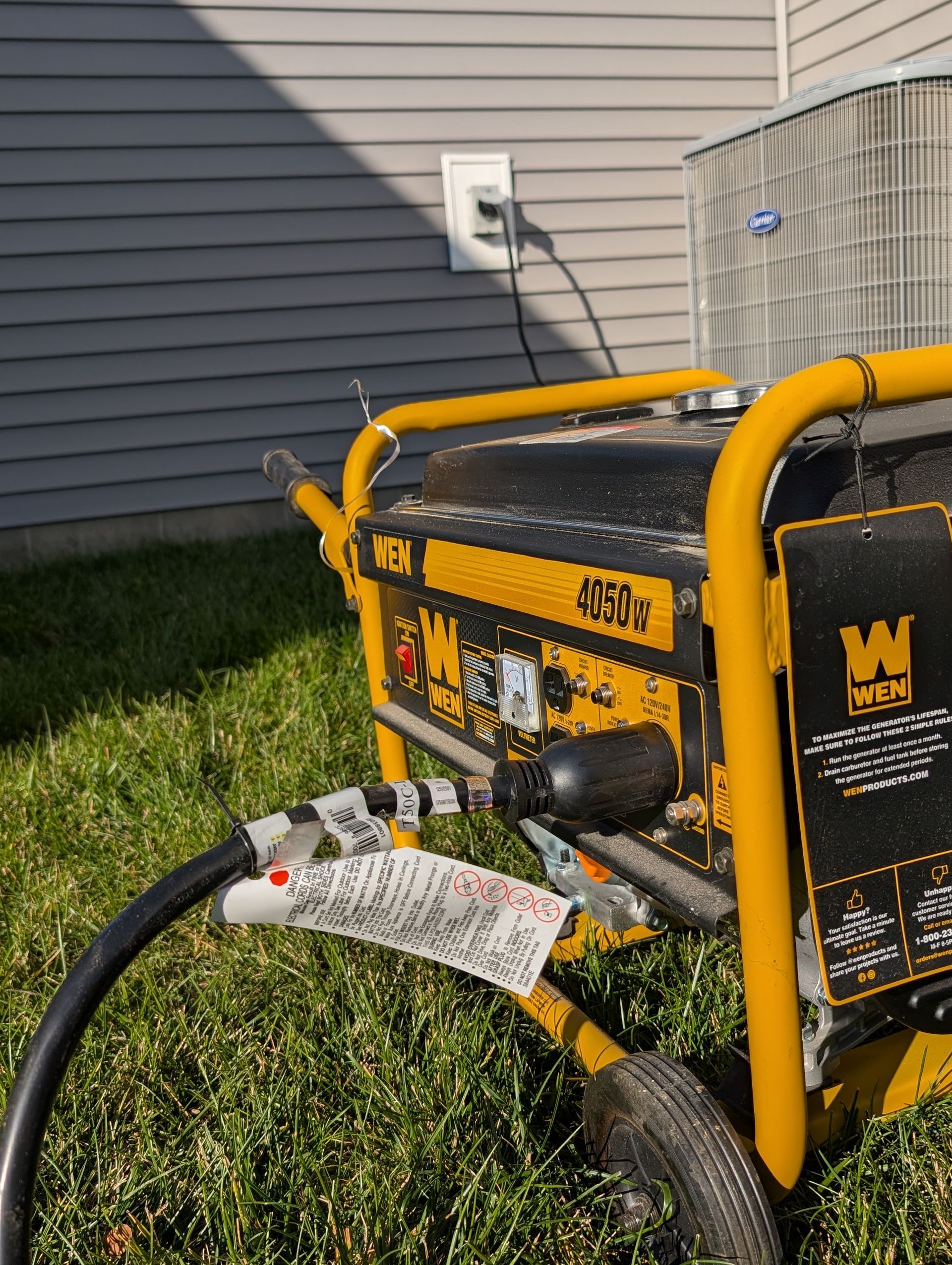
October 23, 2024
Power outages can strike unexpectedly, and when they do, a portable generator can be a lifesaver. Whether it's due to downed utility lines, storms, or blackouts, these devices provide a temporary solution for keeping essential appliances running. However, using portable generators safely is critical to avoiding dangerous situations. From preventing carbon monoxide poisoning to avoiding electrical hazards like backfeeding, following our generator safety tips is key to protecting both your home and family. Why Portable Generator Safety is Crucial Portable generators are handy machines, but improper use can lead to serious hazards. Generators emit carbon monoxide (CO), a toxic and potentially deadly gas that can build up quickly in enclosed spaces. Additionally, electrical issues, such as backfeeding a generator, can create a serious risk for utility workers or anyone in the home. Before you start your generator, understanding these dangers and following safety protocols can make all the difference. 1. Preventing Carbon Monoxide Poisoning Carbon monoxide is an invisible, odorless gas produced by the combustion process in portable generators. Exposure to CO can cause severe illness or even death in minutes. Here are some portable generator safety tips to minimize the risk of CO poisoning: Always operate the generator outdoors in a well-ventilated area, at least 20 feet away from any windows, doors, or vent openings. Never use a generator inside your home, garage, or enclosed space, even with the door open. This is a common mistake that can lead to deadly CO exposure. Install carbon monoxide alarms in your home, especially near sleeping areas, to alert you if CO levels become dangerous. Make sure the generator’s exhaust is directed away from your home and other buildings. These precautions are essential in keeping your home safe while your generator is running. 2. Avoiding Electrical Hazards A critical aspect of generator safety involves managing the flow of electricity. Improper connections can lead to electrocution, fire hazards, and damage to your appliances. Use the right cords. Ensure all appliances are connected directly to the generator using heavy-duty, outdoor-rated extension cords. Inspect cords for cuts, tears, and make sure they have a three-pronged plug, including the grounding pin. Never plug the generator directly into a wall outlet. This can cause backfeeding, a dangerous situation where electricity flows back into power lines. Not only is this illegal, but it poses a severe risk to utility workers trying to repair the lines, as well as others in your home. To avoid backfeeding, have a qualified electrician install a transfer switch or an interlock kit that isolates the generator's power from the utility grid. This allows you to safely connect the generator to your home’s wiring system and ensures that both power sources cannot operate simultaneously. If you're looking for a professional installation to ensure your generator is set up safely and efficiently, check out our Generator Installation Services. Turn off the generator before refueling. Generators get extremely hot during operation. Refueling a hot generator can lead to fire hazards, so always allow it to cool down before adding more fuel. 3. Handling Fuel Safely Fuel storage and usage are key elements of generator safety. Because fuel is highly flammable, it’s important to store it carefully and use it safely when refueling the generator. Store fuel in proper containers. Always use containers labeled for gasoline storage and keep them in a well-ventilated area away from living spaces. Turn off and cool down the generator before refueling. This simple step can prevent dangerous fires. Keep generators dry. Never operate a generator in wet conditions, as water can cause short circuits and electrical shock. Use your generator on a dry surface and, if necessary, cover it with a canopy to keep it dry. 4. Additional Generator Tips Here are some other tips to ensure your portable generator is operating as safely as possible: Perform regular maintenance. Like any machine, your generator needs upkeep to run efficiently and safely. Follow the manufacturer’s instructions for changing oil, replacing filters, and inspecting the system. Test your generator regularly. It's a good idea to test the generator periodically, even when you don't need it. This ensures it's ready for action when an outage occurs. Know your wattage limits. Overloading your generator by trying to power too many appliances can cause it to overheat, leading to fires or damage. Know the wattage limits of your generator and prioritize essential devices like refrigerators, sump pumps, and lights. Download our Generator Safety Practices PDF for a handy reference guide to keep you informed about generator safety procedures. Are You Curious About How to Hook Up Your Portable Generator to Your House? If you're ready to safely connect your portable generator to your home, check out our Generator Installation Services and learn how.
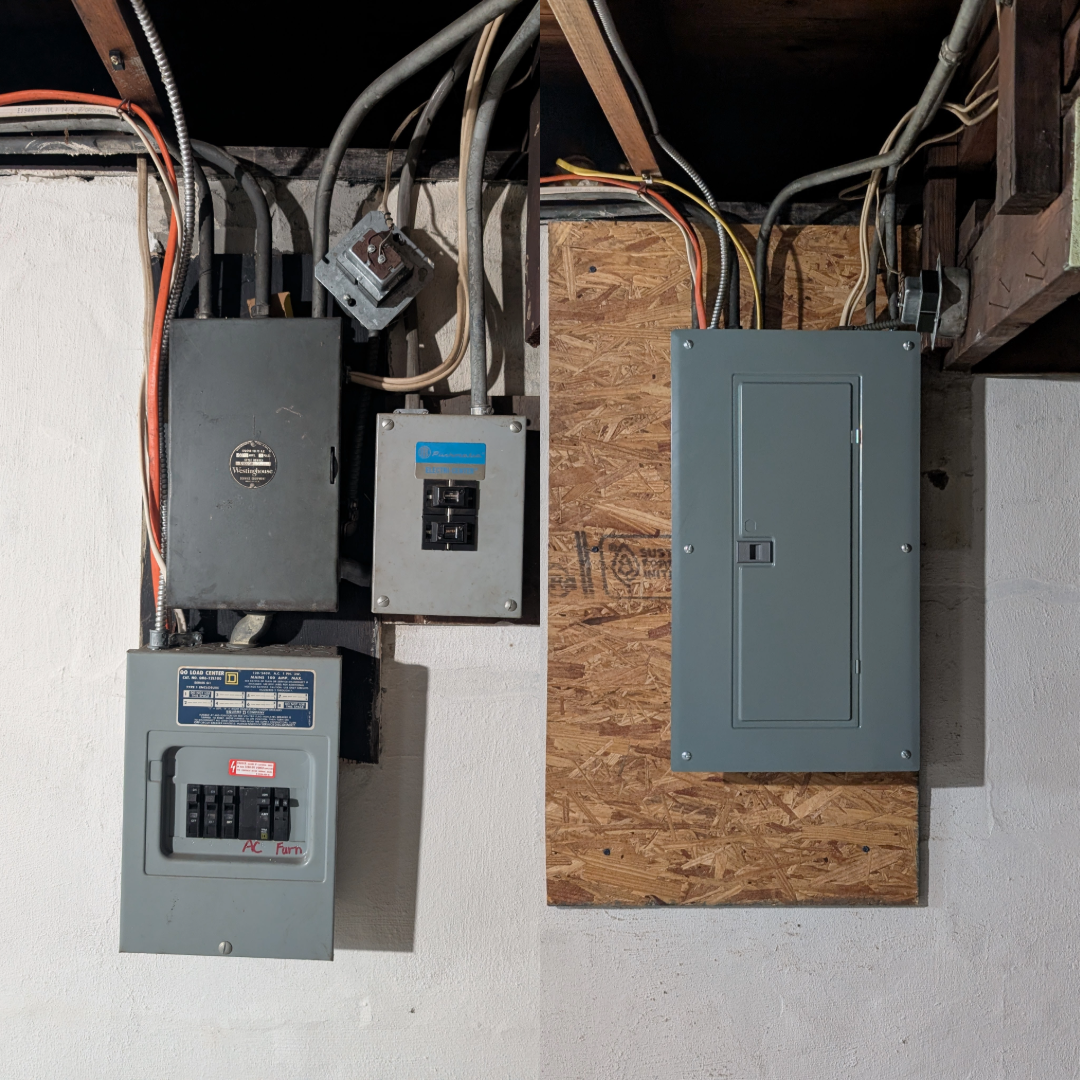
September 9, 2024
The electrical panel is like the heartbeat of your home’s electrical system, silently working behind the scenes to keep everything powered. But what happens when that heartbeat starts to falter or can’t keep up with the demands of modern life? The decision to upgrade or replace your electric panel isn’t always an easy one, but it's one that could impact your safety, property value, and even your future plans. Let’s dive into some of the most compelling reasons why upgrading might be the right move for you. 1. Safety Concerns: The Hidden Danger in Old Panels Imagine relying on a decades-old system to power today’s high-tech world. Many homes still have electrical panels that are dangerously outdated. We’re talking about Federal Pacific, Zinsco, Push o matic, and even fuse boxes. These panels are famous for failing under pressure. The risk? Overheating, fire hazards, and potential electrical failures. If your panel shows signs of rust or damage, you’re not just dealing with an eyesore, you're dealing with a safety risk. In fact, many insurance companies won’t insure homes with fuses because of the danger. The cost of replacing your electric panel is small compared to the peace of mind that comes with knowing your home is protected. 2. Prevent Overloading: More Power, Fewer Problems Modern homes demand more power. Between smart devices, larger appliances, and even electric cars, it’s easy to overload an old electrical panel. If you’re experiencing constant breaker trips, flickering lights, or even appliances that seem to struggle, your panel might be waving a white flag. Upgrading helps prevent overloading, and more importantly, it protects the rest of your home from the damage that power surges and outages can cause. 3. Boost Your Property Value: The Upgrade Buyers Will Love A modern electrical panel isn't just about functionality, it’s an investment in your home’s value. Buyers today are more educated about what makes a home not only desirable but also safe. An outdated panel can turn away potential buyers and could even affect the resale price of your property. By replacing your electric panel, you’re making your home more marketable, which could be the deciding factor for future buyers. 4. Support Room Additions or Remodeling: Powering Your Vision If you’re dreaming of adding that extra room, building out a home office, or remodeling your kitchen, your current panel might not be able to handle the extra load. Even small projects can push an older panel to its limits. Before you find yourself halfway through a renovation with an overloaded system, consider upgrading to ensure your home has the power to match your vision. Think of it as future-proofing your home for any expansion you have in mind. 5. Prepare for Electric Vehicle Charging or a Hot Tub: Ready for the Next Step Whether you’re adding a hot tub for weekend relaxation or considering an electric vehicle, these require a significant power boost. A hot tub electrical installation or an EV charger installation is not something an older electrical panel can always support. By upgrading your panel now, you’re setting your home up for smooth installations down the road. It’s not just about having enough power; it’s about ensuring everything runs safely and efficiently. 6. Future Proofing: An Investment in Tomorrow’s Tech Technology is advancing faster than ever, and your home needs an electrical system that can keep up. From heat pump systems to fully automated homes, the demand for reliable, high-capacity power isn’t going anywhere. By upgrading your electrical panel, you’re preparing your home for the future.. It’s about building a system that can grow with you, rather than limiting your possibilities. Costs to Consider It's essential to understand the potential costs involved. An electrical panel upgrade cost from 100 to 200 amp can vary depending on the complexity of your current setup. Several factors determine the cost. Whether the electric service is underground or overhead, electrical panel replacements are generally easier when they are surface mounted in a basement vs an in the wall system. A simple 100 amp panel replacement could be as little as $600 but a full 100 to 200 amp service upgrade usually starts around $1,950 and can go up depending on complexity. The Bottom Line: Why Wait? Upgrading or replacing your electric panel is more than just a maintenance decision, it’s an investment in safety, value, and peace of mind. Whether you're worried about safety, facing the limits of your current panel, or planning future home upgrades, making this change is a powerful way to secure your home’s future. Yes, electrical panel upgrade cost and electrical panel replacement cost are factors, but the long-term benefits far outweigh any initial expenses. Is your panel keeping up with your home’s power needs? Our residential services cover everything from panel replacement to upgrades.
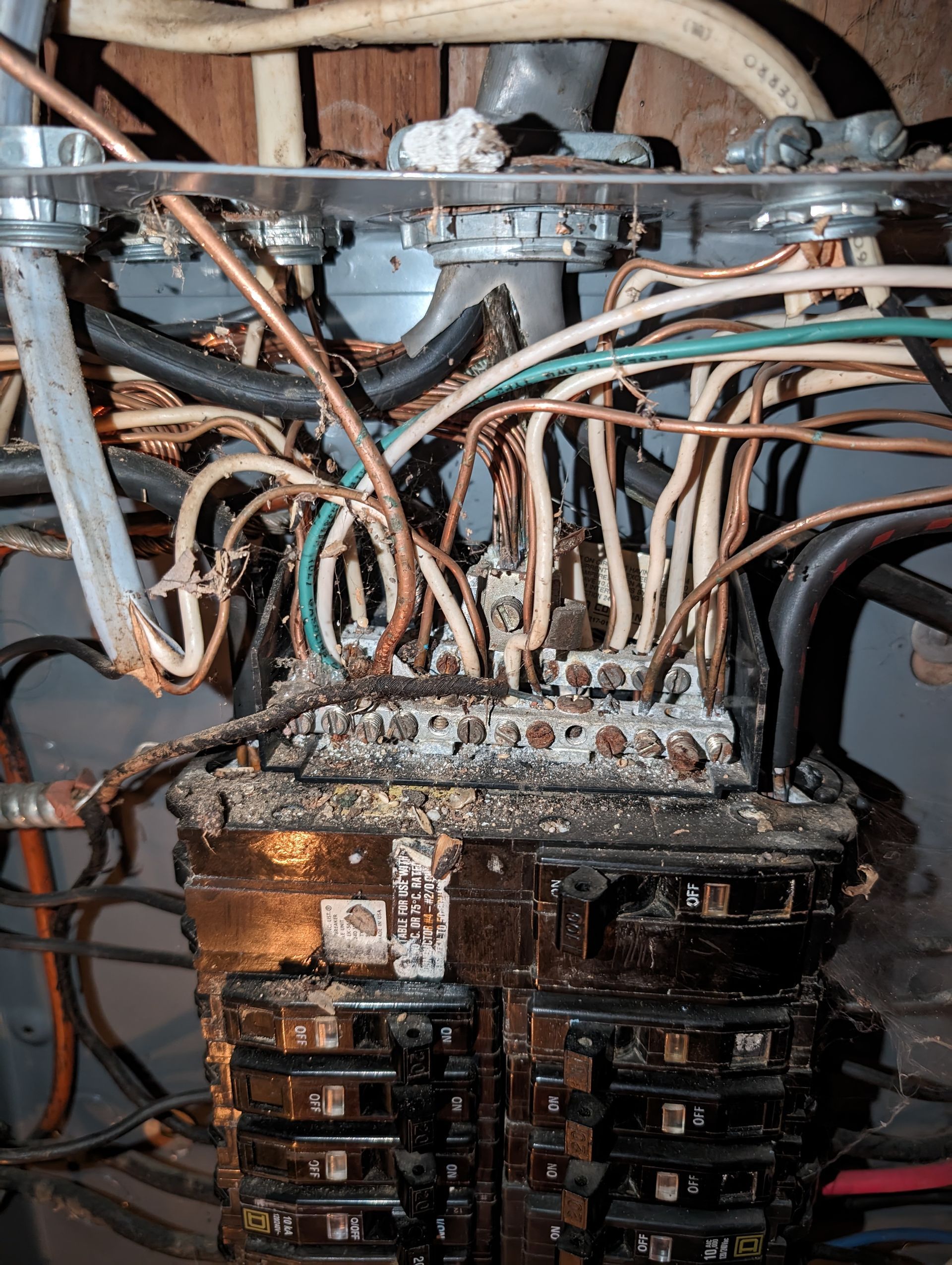
July 23, 2024
Electrical panels are the heart of your home's electrical system, distributing power safely to every part of your house. However, they can sometimes fall prey to corrosion, leading to serious issues. This article is aimed to keep you informed about potential electrical problems and how to prevent them. Let’s delve into what causes corrosion in electrical panels, the signs to look out for, and how to safeguard your system from these issues. What Causes Corrosion in Electrical Panels? Corrosion in electrical panels is often due to moisture. When moisture finds its way into your panel, it can lead to rust and corroded connections. This moisture can come from various sources: Condensation: When warm, moist air hits a cold surface, condensation forms. This can happen inside your electrical panel if there's a gap between the panel and the outside meter, allowing cold air to seep in and meet the warmer indoor air. Humidity: Basements, especially unfinished ones, are prone to higher humidity levels, which can contribute to moisture buildup in your electrical panel. Leaks: Water coming out of breaker boxes or water in circuit breaker boxes can be due to leaks from roofs or plumbing. Signs of Electrical Panel Corrosion Corrosion in an electrical panel is not always immediately visible, but there are several signs you can look for: Rust on the Electrical Panel: Visible rust is a clear indicator that moisture is present. If you see rust on the outside, there's a good chance that rust has developed inside the panel as well. Flickering Lights: Corroded connections can lead to intermittent power supply, causing your lights to flicker. Intermittent Power Outages: Bad electrical panels caused by corrosion can result in inconsistent power to parts of your home. If you notice any of these issues, it’s essential to contact an electrician near you to inspect your panel. The Dangers of Corrosion: Increased Resistance and Heat Buildup Corrosion in an electrical panel does more than just create unsightly rust. It can significantly increase the electrical resistance within the panel. This increased resistance forces your electrical system to work harder to conduct electricity, which can lead to excessive heat buildup. Over time, this heat can degrade the insulation on wires and potentially ignite surrounding materials, posing a serious fire hazard. Preventing Corrosion The good news is that you can take steps to prevent corrosion in your electrical panel. Here’s how: Use Duct Seal: Applying duct seal between your panel and the outside meter and sealing the conduit from inside to outside can prevent cold air from entering the panel and causing condensation. Note: Do not use spray foam; only use certified products meant for electrical panels to ensure safety and compliance with electrical codes. Control Humidity: If your panel is in an unfinished basement, using a dehumidifier can help keep the humidity levels down, reducing the risk of moisture buildup. Regular Inspections: Have a professional from an electric company near you inspect your panel regularly to ensure there are no signs of corrosion or other issues. Why Addressing Corrosion Matters Electrical panel corrosion is not just a minor inconvenience; it can pose serious safety risks. Corroded connections can overheat, potentially leading to electrical fires. Moreover, a bad electrical panel can compromise the efficiency and safety of your entire electrical system. Remember, addressing issues early can prevent more significant problems down the line. Stay vigilant and keep your electrical panel in good condition with regular maintenance and inspections. By taking these preventive measures, you can avoid the headaches and hazards associated with electrical panel corrosion. Concerned About Corrosion in Your Electrical Panel? If you notice rust, flickering lights, or power issues in your home, don’t wait! Contact Bright Electric today to schedule a professional inspection and ensure your electrical panel is safe and corrosion-free. We proudly serve Evansville IN and the surrounding areas —let us help protect your home from electrical hazards!

By By Matt Pinkston, Master Electrician
•
June 10, 2024
Embarking on a career as an electrician in Evansville offers a blend of fulfilling work and promising financial rewards. As a full time electrician for over 25 years, I can tell you that this journey requires dedication, patience, and a lot of hands-on learning. Whether you’re fresh out of high school or considering a career change, knowing what to expect can make the process smoother and more exciting. Starting Your Electrical Career with an Apprenticeship The first step in your electrical career is applying for an apprenticeship. In Evansville, or more specifically Vanderburgh County, you must be signed up for a trade school and registered with the city to work legally. An apprenticeship is a hands-on learning experience where you earn money while working under the supervision of a journeyman electrician. This combination of practical training and education is essential for anyone serious about entering the electrical trade. Trade School Requirements in Evansville In Evansville, electrical apprentices must attend trade school for four years, with classes held two nights a week, three hours each night. This schedule allows you to balance work during the day with your studies in the evening, making it much less demanding and expensive than traditional college. Trade school provides the theoretical foundation needed to complement the practical skills you’ll gain on the job, covering essential topics like electrical theory and the National Electrical Code. Comprehensive On-the-Job Training During your apprenticeship, you’ll learn about common electrical materials, tools, and industry terminology. Apprentices typically rotate through various job sites and tasks, gaining a comprehensive understanding of different aspects of electrical work. This rotation ensures that you develop a well-rounded skill set and are prepared for any challenge you might face in your electrical career. Here are five key categories of work you will learn: 1. Preliminary Work: This involves the initial steps in an electrical project, such as reading blueprints, planning the layout of electrical systems, and preparing the worksite. It's the foundational stage that sets the stage for all subsequent work. 2. Rough-In Work: During this phase, you'll install the basic framework of the electrical system. This includes running wires through walls, installing boxes for outlets and switches, and ensuring that all wiring is correctly routed before the walls are finished. 3. Finish Work: Also known as trim-out work, this stage involves installing the final elements of the electrical system, such as light fixtures, receptacles, switches, and electrical panel boxes. It's the detail-oriented phase where everything is connected and tested to ensure proper operation. 4. Troubleshooting: You'll learn how to diagnose and fix electrical problems, from simple issues like faulty switches to more complex problems involving wiring or circuit breakers. Troubleshooting is a critical skill for ensuring the safety and reliability of electrical systems. 5. Motor Install and Control: This includes the installation and maintenance of electric motors and their control systems. You'll learn about motor types, wiring methods, and control circuits, which are essential for many industrial and commercial applications. Taking the Test and Becoming a Journeyman Electrician After completing your apprenticeship and trade school, you’ll need to take the journeyman’s electrician test. This exam assesses your knowledge of electrical theory and the National Electrical Code. Passing this test is a critical milestone, allowing you to work independently and enjoy the freedom and increase in salary. In Evansville, journeymen must still work under a master electrician who is licensed, bonded, and insured. This ongoing mentorship helps you gain further experience and expertise. A Rewarding Career in Evansville There is nothing more rewarding than looking back at the work you've accomplished at the end of the day, flipping the switch, and watching the lights come on. Embarking on the path to becoming an electrician promises a fulfilling and prosperous future. Embrace the journey and start building a career that is both rewarding and essential to our community. If you are interested in becoming an electrician, fill out our careers form . We accept applications from time to time and would love to hear from enthusiastic individuals ready to join the field. For more information on local trade schools visit the IEC here .
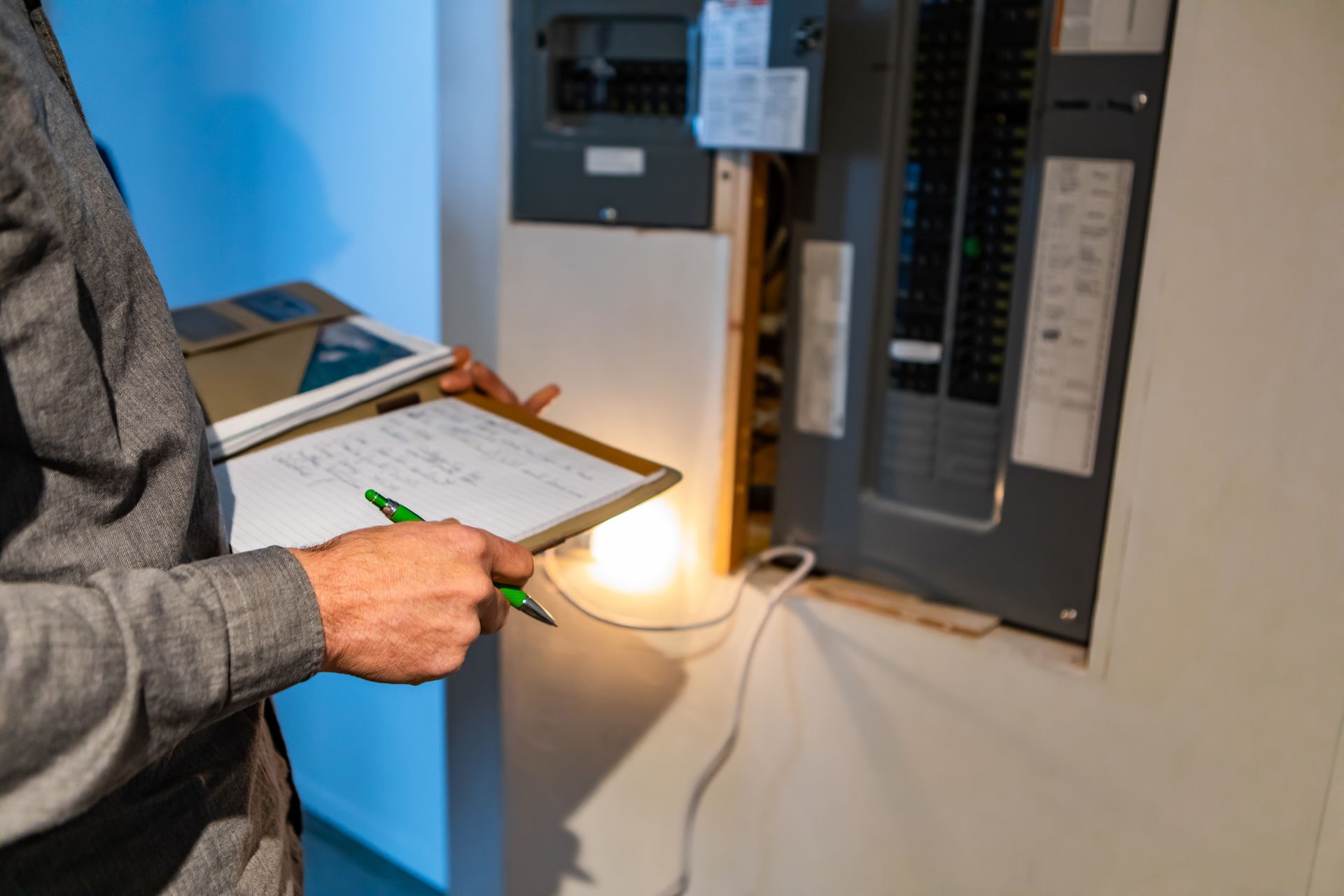
May 14, 2024
Electrical issues are a major cause of concern for homeowners. According to the National Fire Protection Association (NFPA), electrical failures or malfunctions were the second leading cause of home fires in the United States, accounting for an estimated 46,700 home fires annually. Addressing electrical deficiencies promptly is crucial to prevent potential hazards and ensure a safe living environment. Here are some common electrical items found on home inspection reports, along with explanations and repair details: Double Tapped Neutrals What it Means: This occurs when two or more neutral wires are connected to a single terminal in the breaker panel. It can cause electrical arcing and overheating. Repair Involves: An electrician will separate the neutrals and connect each wire to its own terminal to ensure proper circuit function and safety. Double Tapped Circuit Breakers What it Means: Double tapped circuit breakers occur when two or more wires are connected to a single breaker terminal. This can lead to loose connections, overheating, and potential electrical fires. Repair Involves: Adding an additional circuit breaker if applicable or joining the wires together before the circuit breaker. Oversized Circuit Breakers What it Means: A circuit breaker that has a higher amperage rating than the wiring it is protecting can cause the wire to overheat, potentially leading to fires. Repair Involves: Replacing the oversized breaker with one that matches the wire's capacity to prevent overheating and ensure circuit protection. Open Splices What it Means: Electrical connections made outside of a junction box or with exposed wiring can be a potential fire hazard. Electrical boxes with proper covers can contain sparks from improper connections and help to prevent fires. Repair Involves: Securing the splices within a proper junction box and covering them with a cover plate to protect the connections and maintain electrical safety. Wiring Not Protected in Conduit What it Means: Exposed wiring is susceptible to physical damage, which can lead to electrical shorts when damaged. Repair Involves: Running the wiring through a protective conduit to shield it from damage and ensure safe operation. No GFCIs What it Means: Ground Fault Circuit Interrupters (GFCIs) are required in areas with water exposure, such as kitchens, bathrooms, and outdoor spaces, to help prevent electric shock. Repair Involves: Installing GFCI outlets or circuit breakers in required areas to enhance safety by quickly cutting off power in case of a ground fault. Smoke Detectors What it Means: Smoke detectors are crucial for early fire detection and must be properly installed and maintained. Repair Involves: Ensuring all smoke detectors are functional and properly located. Knob and Tube Wiring What it Means: An outdated wiring method that lacks grounding and cannot handle modern electrical loads. Repair Involves: (For detailed information, see our dedicated article on Knob and Tube Wiring.) Typically, replacing the old wiring with modern, grounded wiring systems. Receptacles Missing the Ground Wire What it Means: Three wire receptacles without grounding can increase the risk of electric shock. Repair Involves: (For detailed information, see our dedicated article on Ungrounded Receptacles.) Generally, replacing affected three prong receptacles with two prong receptacles or installing GFCI outlets to enhance safety. Bonding Gas Lines What it Means: Bonding gas lines ensures that any stray electrical current is safely conducted to the ground, reducing the risk of fire or explosion. Repair Involves: Installing a bonding wire between the gas lines and the electrical grounding system to ensure proper current flow. Wiring Not Rated for Outdoor Use What it Means: Indoor wiring used outdoors can deteriorate quickly, posing a risk of electrical shock. Repair Involves: Replacing the wiring with outdoor-rated cables designed to withstand exposure to the elements. Grommets Missing in Electrical Panel What it Means: Grommets protect wires from sharp edges in the electrical panel, preventing insulation damage and potential short circuits. Repair Involves: Installing grommets to safeguard the wiring and maintain electrical panel integrity. Reversed Polarity What it Means: Reversed polarity occurs when the hot and neutral wires are connected to the wrong terminals of an outlet. This misfiring can lead to electrical shocks and damage to electronic devices, as it disrupts the normal flow of electricity. Repair Involves: Repair involves moving the wiring to the correct terminals. Unsafe Electrical Panels (Federal Pacific, Pushmatic, Fuse Panels, Zinsco) What it Means: Certain older electrical panels are known to be unsafe due to design flaws that can lead to circuit breaker failure and fire hazards. Repair Involves: Replacing these panels with modern, safe, and reliable electrical panels to ensure the safety of the home's electrical system. Addressing these common electrical issues is vital for ensuring the safety and reliability of a home's electrical system. If you have any specific questions or need professional assistance, Bright Electric is here to help with all your electrical needs. Our experienced and licensed electricians are well-versed in handling these issues and more, providing you with peace of mind and a safer home. For more detailed information on specific topics like Knob and Tube Wiring and Ungrounded Receptacles, please visit our other articles. If you’re a homeowner who has encountered these common issues, explore our full range of residential services to ensure safe and professional solutions for every electrical need.
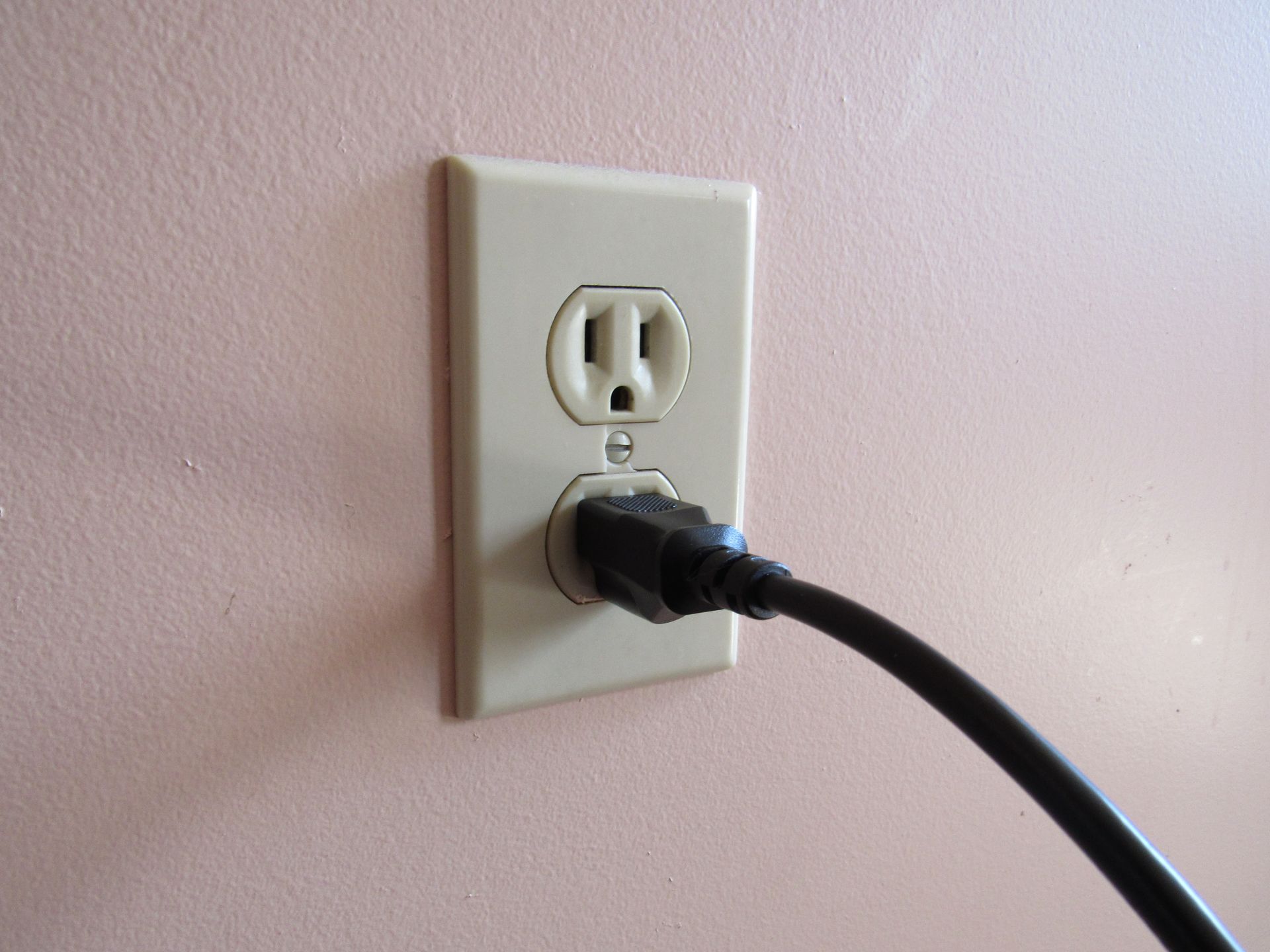
April 23, 2024
During a home inspection, you might receive a report mentioning that some of your three-prong receptacles are ungrounded. This can be confusing, as the presence of three prongs suggests a grounding connection, but the inspector's report contradicts that assumption. Let's delve into the reasons behind this and what it means for your home's safety. The Misleading Three-Prong: Older homes, built before the widespread adoption of grounded wiring in the 1960s, might have two-prong receptacles. These outlets lack a ground wire. However, over time, some homeowners might have replaced these receptacles with three-prong receptacles for aesthetic reasons or ease of plugging in devices. The issue arises because these three-prong receptacles were installed without actually upgrading the underlying wiring to include a ground wire. This creates a situation where the outlet appears to be grounded, but it functionally isn't, leading to ungrounded outlets that can lead to safety concerns and potential damage. Safety Concerns of Ungrounded Outlets: Shock Hazard: In the event of a malfunction in a three-prong appliance plugged into an ungrounded outlet, the metal casing of the appliance can become energized, posing a shock hazard to anyone who touches it. Reduced Functionality: Some modern appliances, like computers and televisions, rely on the ground connection for proper operation and surge protection. An ungrounded outlet can hinder their functionality or even damage them in case of surges. Addressing 2-Prong Ungrounded Receptacles, Understanding the Code: The NEC, in Section 210-7, mandates the installation of grounded receptacles on 15A and 20A branch circuits. This section also emphasizes the importance of effectively grounding these receptacles to the circuit's equipment grounding conductor. Unfortunately, the only way to truly ground these receptacles would be to run new wiring to each affected outlet. Solutions for Non-Grounded Outlets: 1. Replacement with a 2-prong Receptacle: This option allows for a direct swap of the affected 3-prong receptacle with a 2-prong ungrounded receptacle. However, this method does not address the lack of grounding. 2. GFCI-Type Receptacle: Installing a Ground Fault Circuit Interrupter (GFCI) receptacle at each location offers additional protection by continuously monitoring electrical current. If a fault is detected, the GFCI quickly cuts off power, potentially preventing serious electrical issues. This offers the convenience of the 3-prong receptacle and protection of the GFCI. 3. Three-prong Grounding-Type Receptacle with a GFCI Circuit Breaker: This involves replacing the receptacle with a three-prong grounding-type receptacle, but with the crucial addition of GFCI protection from a GFCI circuit breaker. This method offers convenience and enhanced safety. Choosing the Right Option: While all three options comply with the NEC, the best choice depends on the specific situation. For example, installing a single GFCI-type receptacle may be sufficient for isolated areas, but a more comprehensive approach may be necessary for homes with multiple ungrounded outlets. For any questions or guidance on how to properly address ungrounded receptacles or to ground an ungrounded outlet, please reach out to the Bright Electric team!
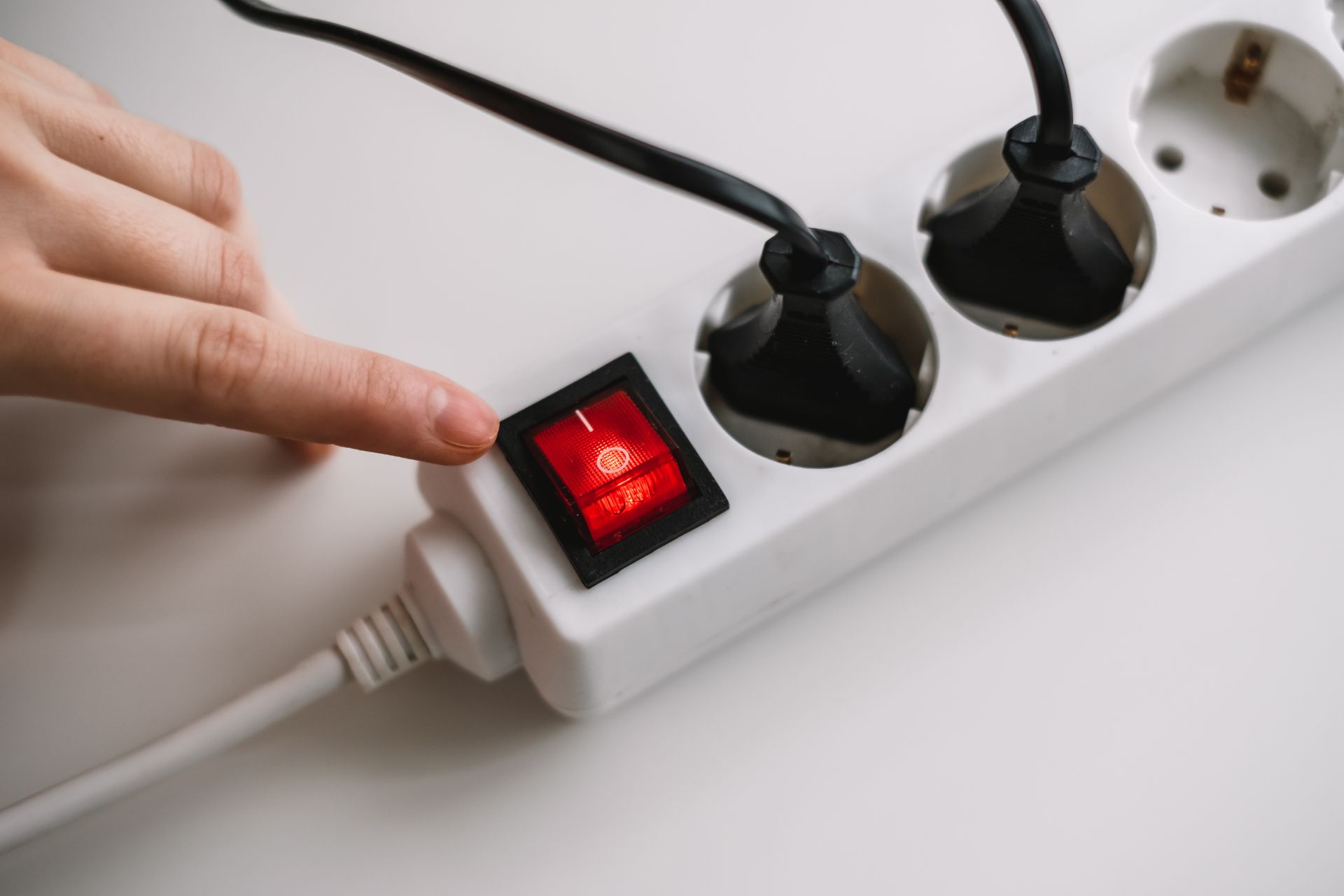
April 23, 2024
If you live in Evansville, you know that a stormy day can mean more than just an afternoon indoors; it could also spell trouble for your home’s electronics. Power surges—those sudden spikes in voltage—are notorious appliance killers, and around here, they’re often sparked by lightning or sudden changes in power line conditions. But not to worry, here’s a handy guide to keeping your gadgets safe from unexpected jolts. Understanding Power Surges Power surges happen when something boosts the electrical charge at some point in the power lines. This can come from lightning, yes, but also from power lines getting knocked about or even from your own home's appliances like refrigerators and air conditioners kicking on and off. While many surges come from outside your home, your own appliances aren't always innocent, so it's wise to guard against both. Assessing the Risk Take a look around your home. Do you have a fancy home theater setup or a home office with computers? These are especially vulnerable to surges. Older homes with outdated wiring might also be at higher risk, so it’s a good idea to get a sense of what you’re dealing with and protect accordingly. Surge Protection Solutions 1. Whole-House Surge Protectors: Think of these as bouncers at your electrical system’s door. Installed at your breaker box, whole-house surge protectors keep those unwanted jolts from entering your home in the first place. They’re an excellent first line of defense and are best installed by someone who knows their way around an electrical panel—a licensed electrician. The cost of a whole-house surge protector is a small price to pay for the protection it offers. 2. Surge-Protected Power Strips: For your prized electronics, these power strips are like having a personal bodyguard. They’re great for computers, entertainment systems, and anything else you’d hate to see fried. Ensure they include a spike protector, as this will be your gadget’s best friend, absorbing any excess energy before it can damage your devices. 3. Uninterruptible Power Supplies (UPS): For the utmost in protection, especially in a home office, a UPS can keep your devices running smoothly even when the power dips or goes out completely. Plus, they protect against surges too, making them a double threat. Installation and Maintenance Get a Pro: Installing a whole-house surge protector isn’t a DIY job unless you’re a certified electrician. So, this is the time to call in the pros. It’s worth it to protect your entire electrical setup, including major appliances and sophisticated electronics. Keep an Eye Out: Regular check-ups on your home’s electrical health can catch issues before they cause trouble. Post-storm inspections are a smart move, especially if you notice any odd electrical behavior like flickering lights or tripped breakers. Insurance and Warranty Must-Knows Check Your Coverage: It’s a good idea to peek at your homeowner’s insurance policy to see what’s covered in terms of surge damage. You might be surprised, and it’s better to know your policy inside and out. Save Those Receipts: For all your surge protectors and UPS devices, hang onto those receipts and warranty documents. They can come in handy if you ever need a replacement or repair down the line. Conclusion Setting up your Evansville home to handle power surges is like putting a safety net under your high-wire electronics. With a little upfront effort to get the right protections in place, you can sit back and enjoy the storm, knowing your home tech is safe from unexpected spikes. Remember, a little prep now can save a lot of hassle (and money) later! Worried about power surges affecting your home? Our residential services cover surge protection.
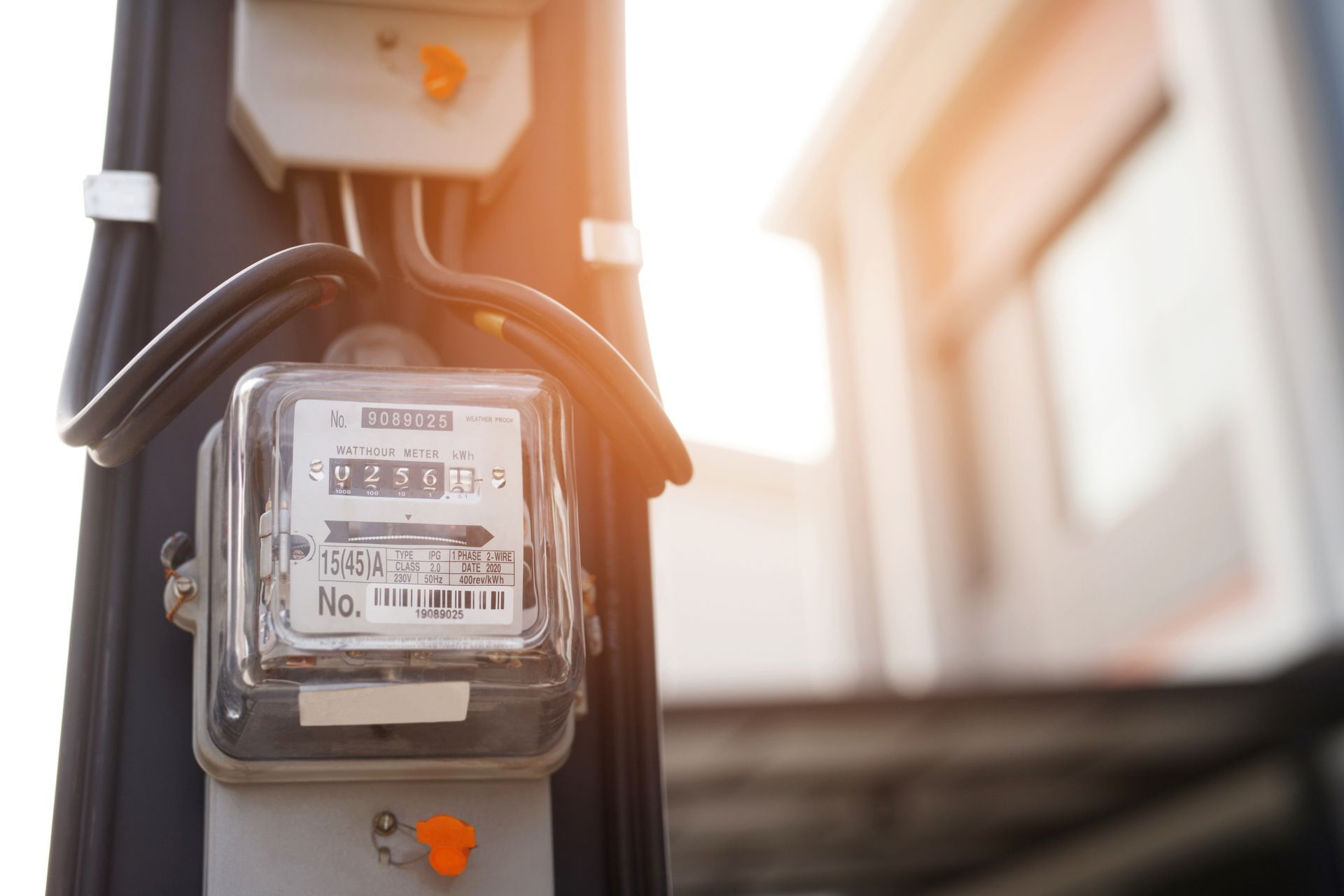
April 23, 2024
At Bright Electric, we understand the complexities involved in upgrading or relocating your electrical meter. Whether you're considering moving your electric meter to an outside wall or simply upgrading it for efficiency, this guide aims to demystify the process and provide a clear understanding of what to expect when you choose us for the job. 1. Permitting Process: Streamlined paperwork: Bright Electric will handle all necessary permit applications with your local authorities. We ensure all documentation is accurate and complete to avoid any delays in your project timeline, whether you're relocating your electric meter or upgrading it. 2. Project Execution: Experienced and licensed electricians: Our team will perform the upgrade or relocation according to the National Electrical Code and safety protocols. Minimal disruption: We work diligently to minimize any disruptions to your daily routine and ensure the work area remains safe and organized. Transparent communication: You will be kept informed throughout the process with regular updates on the project's progress. 3. City Inspection: Code compliance verification: Once work is complete, a city inspector will visit the property to verify compliance with all applicable building codes and electrical safety regulations. The city inspector will notify CenterPoint that the work has been approved. 4. Reconnection to the Grid: With your consent, Bright Electric will coordinate with CenterPoint Energy to disconnect your existing service and schedule a reconnection to the grid once the project is completed and approved by the city inspector. Additional Information: Cost Considerations: The cost to move an electric meter can vary based on several factors, including the complexity of the move and any additional construction required. Bright Electric provides upfront pricing after a detailed assessment, ensuring there are no surprises. Project timelines: While the specific timeline will vary depending on the project's complexity and permitting requirements, Bright Electric will provide a realistic timeframe during the initial assessment. For homeowners thinking about moving their electric meter on the house to a more convenient or safer location, or those looking into the cost and logistics involved, Bright Electric is here to guide you through each step of the process. For questions or guidance, please reach out to the Bright Electric team! We’re here to help make your meter upgrade or relocation as smooth and straightforward as possible.

April 23, 2024
Knob and tube wiring, once a standard electrical installation in older homes, represents a charming piece of history but comes with significant risks if left exposed. For homeowners in Evansville, especially those in historical properties, it's crucial to consider knob and tube removal or replacement for enhanced safety and compliance with current electrical standards. Why Remove Exposed Knob and Tube Wiring and Add GFCI/ARC Fault Breakers? Safety Priority: Over time, the insulation around knob and tube wiring can deteriorate, leaving wires exposed and vulnerable to damage. This can lead to potential fire hazards, particularly in areas where the wiring is easily accessible. Inadequate Grounding: Original knob and tube systems lack the grounding conductors that modern electrical systems use, increasing the risk of electrical shocks and fires. Removing knob and tube wiring and upgrading your system with modern wiring can significantly enhance the safety of your home. Homeowners Insurance Challenges: Many insurance companies hesitate to insure homes with outdated knob and tube electrical systems due to the increased risk of fire. Replacing knob and tube wiring could not only make your home safer but may also ease the process of obtaining homeowners insurance. Modern Demands: Designed for a much simpler era, existing knob and tube wiring systems in Evansville homes are often not capable of handling the electrical load demanded by today's appliances and technology, which can lead to circuit overloads and overheating. Enhanced Protection with GFCI Breakers: Incorporating GFCI (Ground Fault Circuit Interrupter) and ARC fault breakers into your new electrical system provides advanced protection. These breakers are designed to prevent electrical shocks and fires by interrupting the flow of electric current in unsafe conditions. Local Regulations and Recommendations Vanderburgh County's stance on knob and tube wiring underscores the importance of updating electrical systems for safety. While the county does not mandate the removal of knob and tube wiring that is safely concealed within non insulated walls, it strongly mandates the removal of any exposed wiring. At Bright Electric, we support this initiative and encourage local homeowners to comply with these safety guidelines. Cost Considerations The cost of knob and tube wiring replacement can vary depending on the extent of the existing wiring and the specifics of your home’s construction, especially if the wiring is within insulated plaster walls. Replacing knob and tube wiring often involves not only the removal of old wires but also the installation of new, up-to-code electrical systems throughout the house. For those living in older homes or considering home renovations, addressing any existing knob and tube wiring should be a priority. If you have any questions or need guidance on knob and tube replacement costs or procedures, please reach out to the Bright Electric team. We’re here to help ensure that your home’s electrical system is safe, efficient, and up to date.
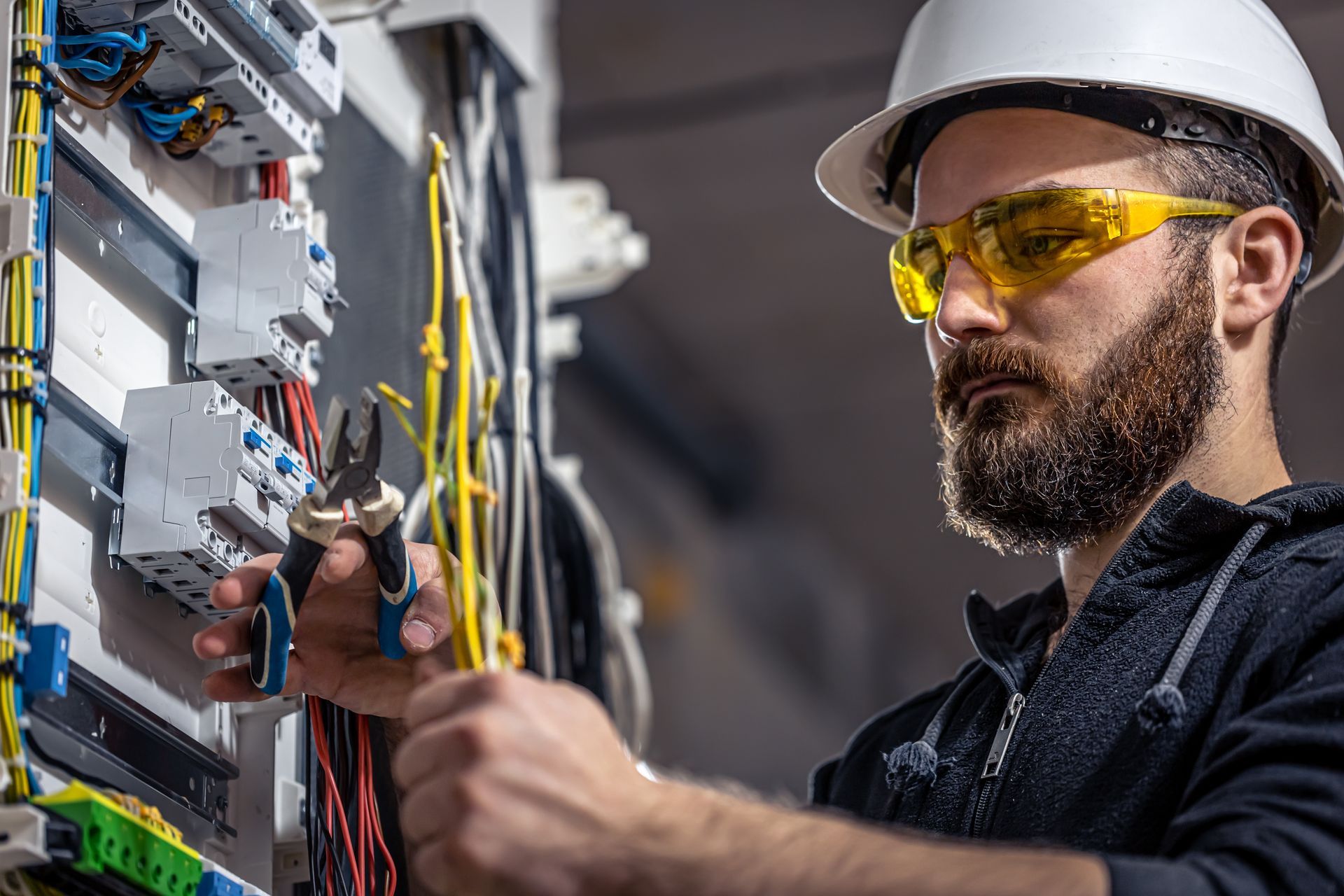
April 23, 2024
Choosing the right electrician is crucial for ensuring the safety and reliability of your electrical services. In Evansville, it is not just about finding someone who can perform the job; it’s about ensuring that the electrician adheres to the legal and professional standards set by local regulations. Here’s what you need to know when selecting an electrician to ensure they are qualified, licensed, and capable of carrying out your electrical work safely and competently. Ensure They Are Licensed, Bonded, and Insured In Evansville, as in many other places, electricians must be licensed, bonded, and insured. This trio of credentials protects you as a homeowner in several ways. Licensing proves the electrician has met specific training and qualification standards. Being bonded provides you with financial protection if the job is not completed as agreed. Insurance, on the other hand, protects you from liability if injuries or property damage occur during the project. Understanding the Different Levels of Electrician Licensing Evansville electricians come in different licensing categories, primarily distinguished by experience and expertise: Master Electricians are at the top of the licensing hierarchy and are responsible for overseeing both journeymen and apprentice electricians. They can handle all levels of electrical work from installation to maintenance and complex repairs. Only Master electricians are allowed to pull permits. Licensed Journeyman Electricians are permitted to work on various projects but must operate under the supervision of a master electrician. They can perform all electrical work in the field. Licensed Apprentice Electricians are in the early stages of their career and must work under the direct supervision of journeyman electricians. They are learning the trade through hands-on experience but do not yet have the expertise to work independently. Additionally, every electrician working in the field is required to carry their electrical license card at all times to verify their qualification status when on the job. Illegal Practices to Watch Out For First Warning Sign: The electrician arrives in an unmarked van or truck. Electricians in Evansville are required to have their business name and license number clearly displayed on their vehicle. This not only promotes transparency but also complies with local regulations. Cutting Costs: Unfortunately, some companies may try to cut corners to save on costs. A common issue is sending out third or fourth-year apprentice electricians to work without the presence of a journeyman. This practice is not only illegal but also puts the customer at risk due to the apprentices' relatively lower level of knowledge and experience. Such actions can lead to substandard work that may not meet safety standards and could potentially cause serious issues. Verifying Credentials When in doubt about the qualifications of your electrician, do not hesitate to call the Evansville Building Commission. They can provide information regarding the license status of the electrician and confirm whether they are authorized to work in Vanderburgh County. This step is crucial for your safety and ensures compliance with local building codes and regulations. The Risks of Hiring an Unlicensed Electrician Hiring an unlicensed electrician might seem like a cost-effective option, but it comes with significant risks. Most insurance policies will not cover damages that occur as a result of work done by an unlicensed electrician. This lack of coverage can leave you vulnerable to costly repairs and replacements if something goes wrong, not to mention the potential safety hazards that could arise from improperly completed electrical work. Conclusion Selecting the right electrician is essential for the safety, efficiency, and legality of your electrical installations and repairs. By ensuring that your electrician is properly licensed, supervised, and compliant with local regulations, you protect your home, your finances, and your family’s wellbeing. Always take the time to verify the credentials and reputation of any electrician you consider hiring to ensure they meet the high standards required in Evansville.


